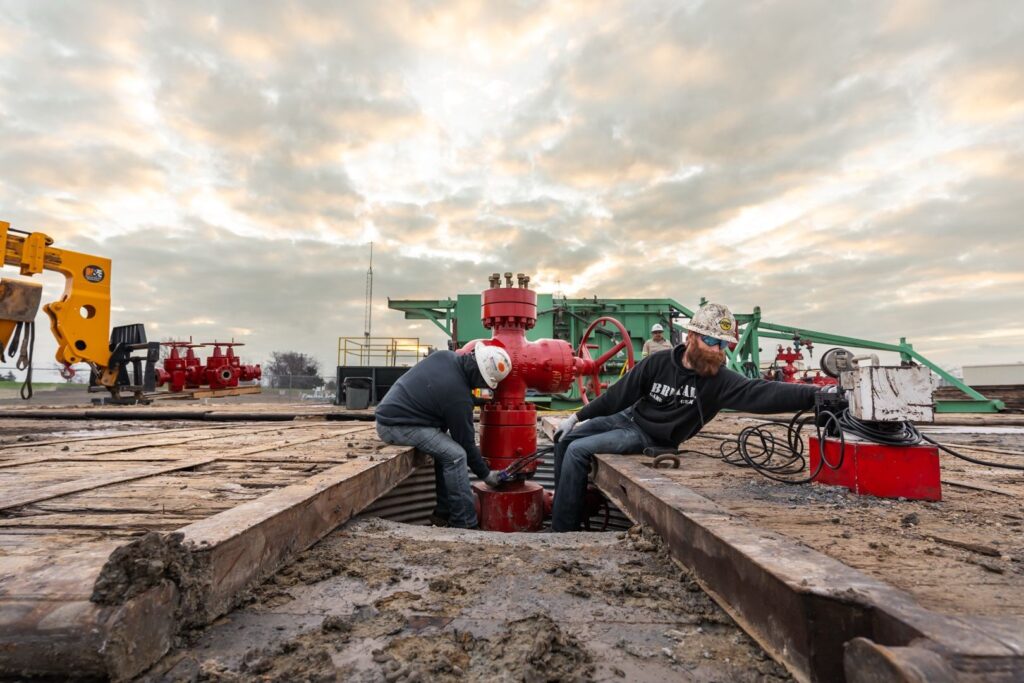Table of Contents
A wellhead is the structural and pressure-containing component installed at the surface of a well—whether oil, gas, thermal (SAGD, CSS, geothermal), or hydrogen. It provides the secure interface between the well’s subsurface casing and tubing and the surface equipment used for drilling, production, and control.
Every well, regardless of resource type, relies on a wellhead to safely contain pressure, control flow, and support equipment. Without it, modern energy production would not be possible.
The Role of the Wellhead in Energy Production
The primary function of a wellhead is pressure control—to contain and manage the intense pressures encountered in the well. It maintains well integrity by sealing off the annulus (the space between casing and tubing) and providing a secure base for valves, flowlines, and control systems.
In addition, the wellhead:
Supports the weight of the casing and tubing strings.
Provides access for pressure testing, sampling, and well intervention.
Controls and directs flow into surface facilities.
Enables safe installation of blowout preventers (BOPs) during drilling.
A properly engineered wellhead ensures safety, reliability, and longevity for the entire life of the well.
How Does a Wellhead Work?
A wellhead works as both a mechanical support and a pressure barrier. It is attached to the casing string cemented into the wellbore and provides a sealed connection to the production tubing. Through this assembly, operators can control the production of fluids—or inject fluids, steam, or gases—safely and efficiently.
Valves and fittings on the wellhead regulate the flow of fluids from the well into production facilities. The upper portion of the wellhead connects to the Christmas tree—a system of valves and spools that provides further control and monitoring.
In thermal wells such as SAGD or CSS, the wellhead must also manage the expansion and contraction caused by extreme temperature cycling. In hydrogen wells or storage systems, the wellhead must resist hydrogen embrittlement and maintain tight seals to prevent leakage of the smallest element in the universe.
Main Components of a Wellhead
| Component | Function | Key Considerations |
|---|---|---|
| Casing Head | The base section that supports and seals the first casing string. | Must withstand axial and pressure loads; for thermal/hydrogen wells, materials must resist temperature cycling or hydrogen effects. |
| Casing Spools & Hangers | Support additional casing strings and isolate annular spaces. | Proper seal integrity is essential for well control. |
| Tubing Head & Tubing Hanger | Support production tubing and provide access to the annulus. | For thermal wells, must handle expansion; for hydrogen, low-permeation seals are required. |
| Valves | Control production, injection, and safety operations. | Includes master, wing, and choke valves; hydrogen valves must prevent gas diffusion. |
| Choke & Kill Lines | Used to manage pressure and inject kill fluids. | Must match the well’s pressure rating and environment. |
| Christmas Tree | Set of valves installed atop the wellhead to control and monitor flow. | Common in production wells of all types. |
| Annulus Vent Flow (AVF) Line | Vents gas or pressure from annular spaces. | Monitored to detect leaks or integrity issues. |
| Adapter Spool / Connector | Links the wellhead to surface facilities or manifolds. | Customizable for different well types. |
Wellhead Sizes and Pressure Ratings
Wellheads are not one-size-fits-all. They are engineered for the depth, pressure, and temperature of each well.
Pressure Ratings: Common working pressure ratings include 2,000 psi, 5,000 psi, 10,000 psi, 15,000 psi, and up to 20,000 psi for HPHT (high pressure, high temperature) applications.
Temperature Classes: Rated for environments from subzero to several hundred degrees Celsius.
Material Classes: Defined by corrosion resistance, fluid compatibility, and strength.
In thermal recovery wells, wellheads must endure repeated heating and cooling cycles.
In hydrogen systems, designs must prevent micro-leakage and resist hydrogen-induced stress cracking.
Specialized Wellheads for Thermal and Hydrogen Applications
Thermal Wellheads (SAGD, CSS, Geothermal)
Thermal wells use steam or heat to mobilize heavy oil or generate renewable geothermal energy. These operations expose wellheads to extreme temperature fluctuations and high cycling stresses. Stream-Flo’s Thermal Wellheads are engineered to:
Tolerate high temperatures and steam erosion.
Maintain seal integrity through thermal expansion cycles.
Support steam injection and production through the same wellbore.
Extend service life with robust materials and replaceable seal systems.
Thermal applications include:
SAGD (Steam Assisted Gravity Drainage)
CSS (Cyclic Steam Stimulation)
Geothermal Energy Production
Hydrogen Wellhead Systems
As the energy industry evolves, hydrogen is becoming a key enabler of decarbonization. Hydrogen’s small molecular size and reactivity demand advanced engineering. Stream-Flo’s Hydrogen Wellhead Systems are designed to:
Safely contain and control hydrogen under pressure.
Prevent embrittlement through hydrogen-resistant materials.
Minimize leakage and permeation with enhanced sealing systems.
Support hydrogen injection, storage, or blending projects.
These innovations are part of Stream-Flo’s broader Equipping Decarbonization initiative — supporting the transition to lower-carbon energy through proven engineering excellence.
Installation, Operation, and Maintenance

Installation: The wellhead is attached to the top of the surface casing and cemented in place. Blowout preventers are mounted on top during drilling for pressure control.
Completion: After drilling, additional spools and the Christmas tree are installed to manage production.
Operation: Operators monitor pressure, temperature, and flow through valves and sensors.
Maintenance: Regular inspections, seal replacements, and pressure testing maintain safety and efficiency.
Lifecycle Management: In thermal and hydrogen systems, monitoring for expansion, fatigue, or material degradation is critical for long-term performance.
Certification and Standards
Wellheads must comply with stringent international standards to ensure safety, reliability, and performance in the world’s most demanding environments.
Stream-Flo wellheads are engineered and manufactured in accordance with:
API Spec 6A – Specification for wellhead and Christmas tree equipment, defining design, performance, materials, and testing requirements.
API Spec 6B – Specification for flanged wellhead and Christmas tree equipment, addressing pressure-containing bolted flange connections and their performance verification.
API Q1 – Quality management system requirements specific to the oil and gas industry.
ISO 10423 – International equivalent of API 6A, providing global consistency in wellhead design and qualification.
NACE MR0175 / ISO 15156 – Material selection standards for resistance to sulfide stress cracking and corrosion in H₂S-containing environments.
By adhering to these standards, Stream-Flo ensures each wellhead system meets or exceeds regulatory and customer expectations for pressure control, sealing integrity, and long-term reliability across oil, gas, thermal, geothermal, and hydrogen applications.
The Importance of Wellhead Innovation
As global energy production shifts toward decarbonization and diversification, the wellhead remains at the heart of every well — conventional or emerging. Innovations in metallurgy, sealing technology, and smart monitoring allow modern wellheads to:
Operate safely in HPHT and corrosive environments.
Support advanced thermal and hydrogen applications.
Integrate sensors and digital monitoring for predictive maintenance.
Reduce downtime and extend service life.
Vital Pressure Control and Production Enhancement
Wellheads are where energy becomes accessible. They enable safe, efficient production and provide the control required for sustainable, responsible energy development. Whether producing hydrocarbons, generating geothermal heat, or managing hydrogen, wellheads are essential to the future of global energy.
